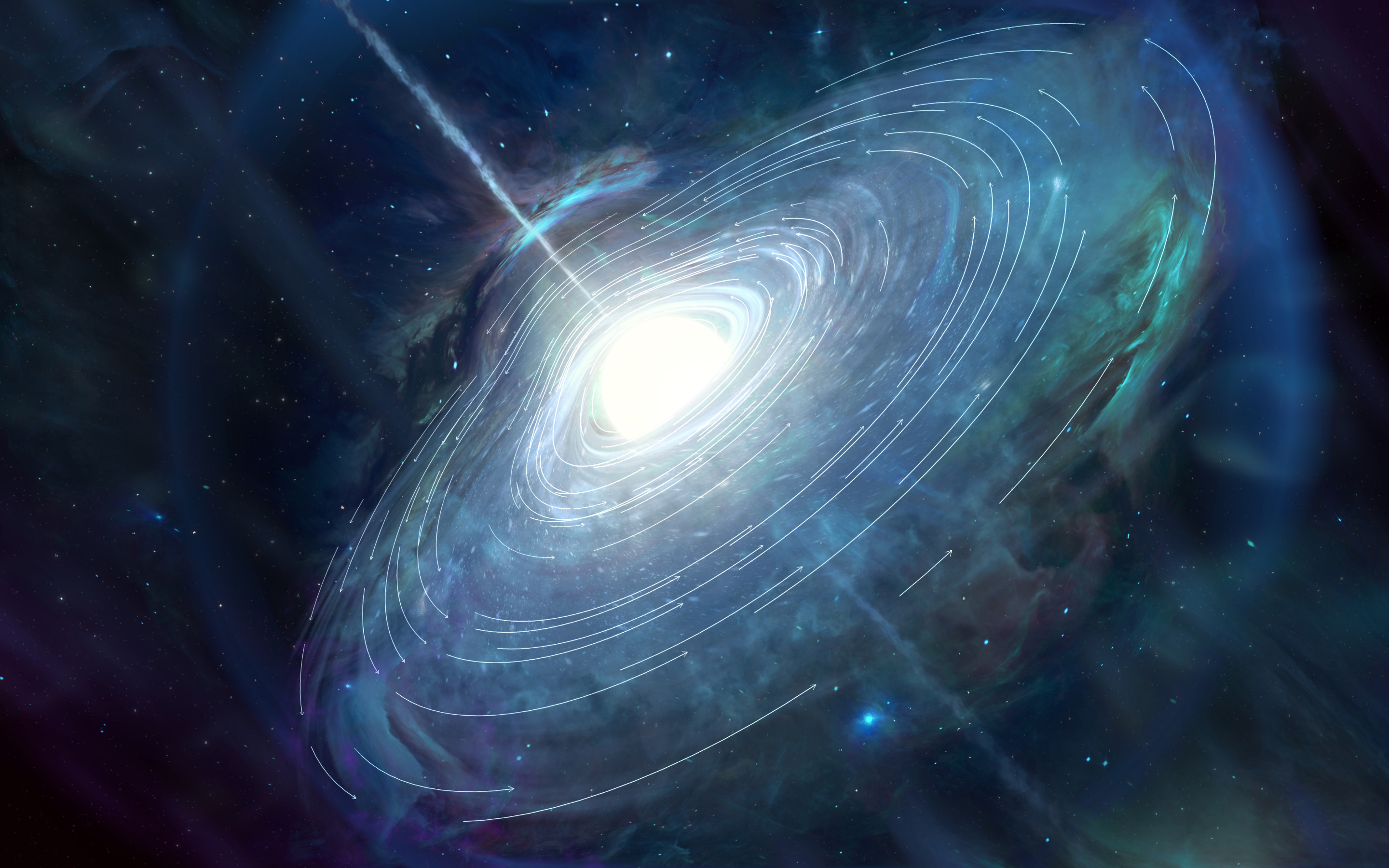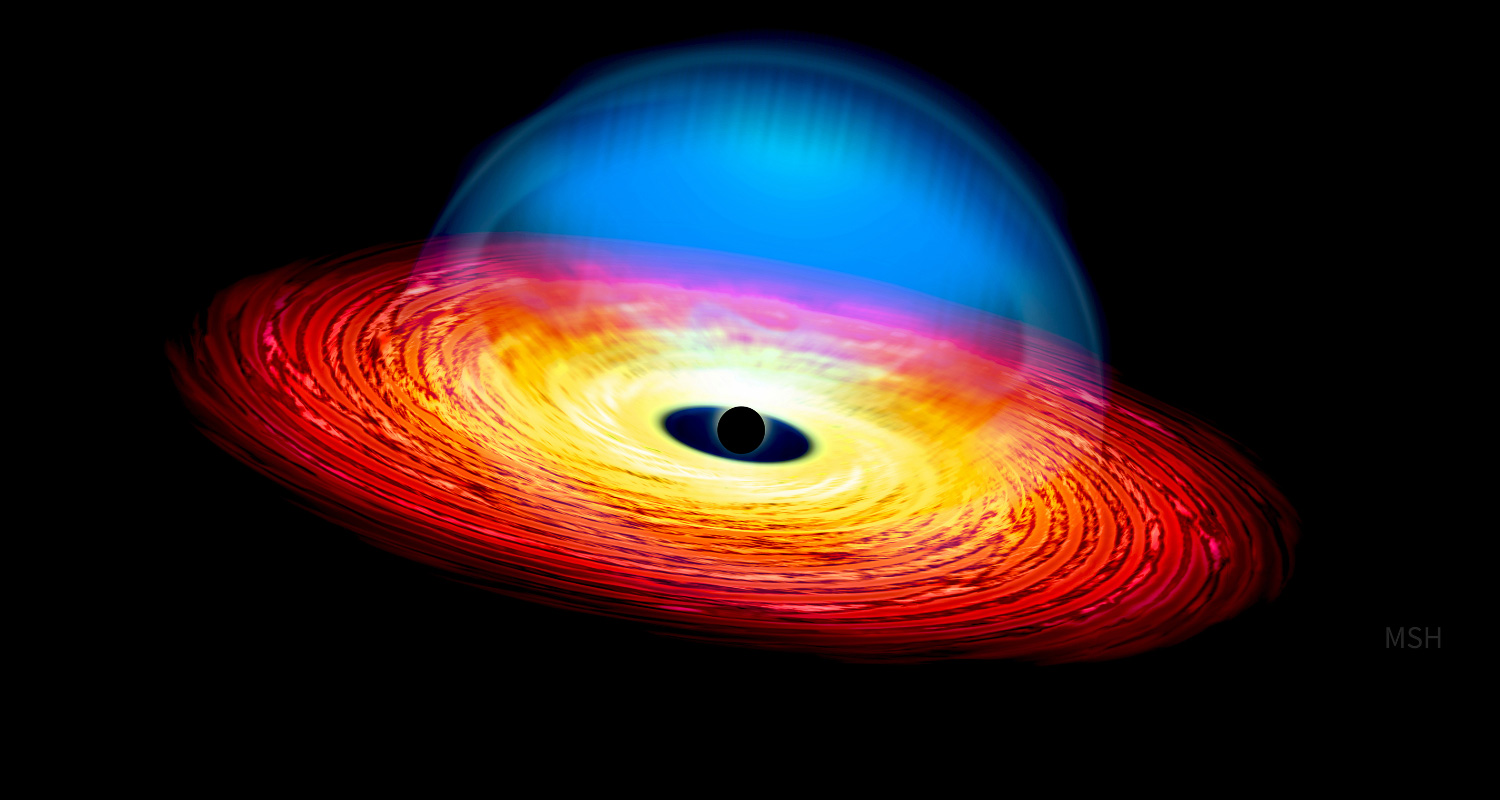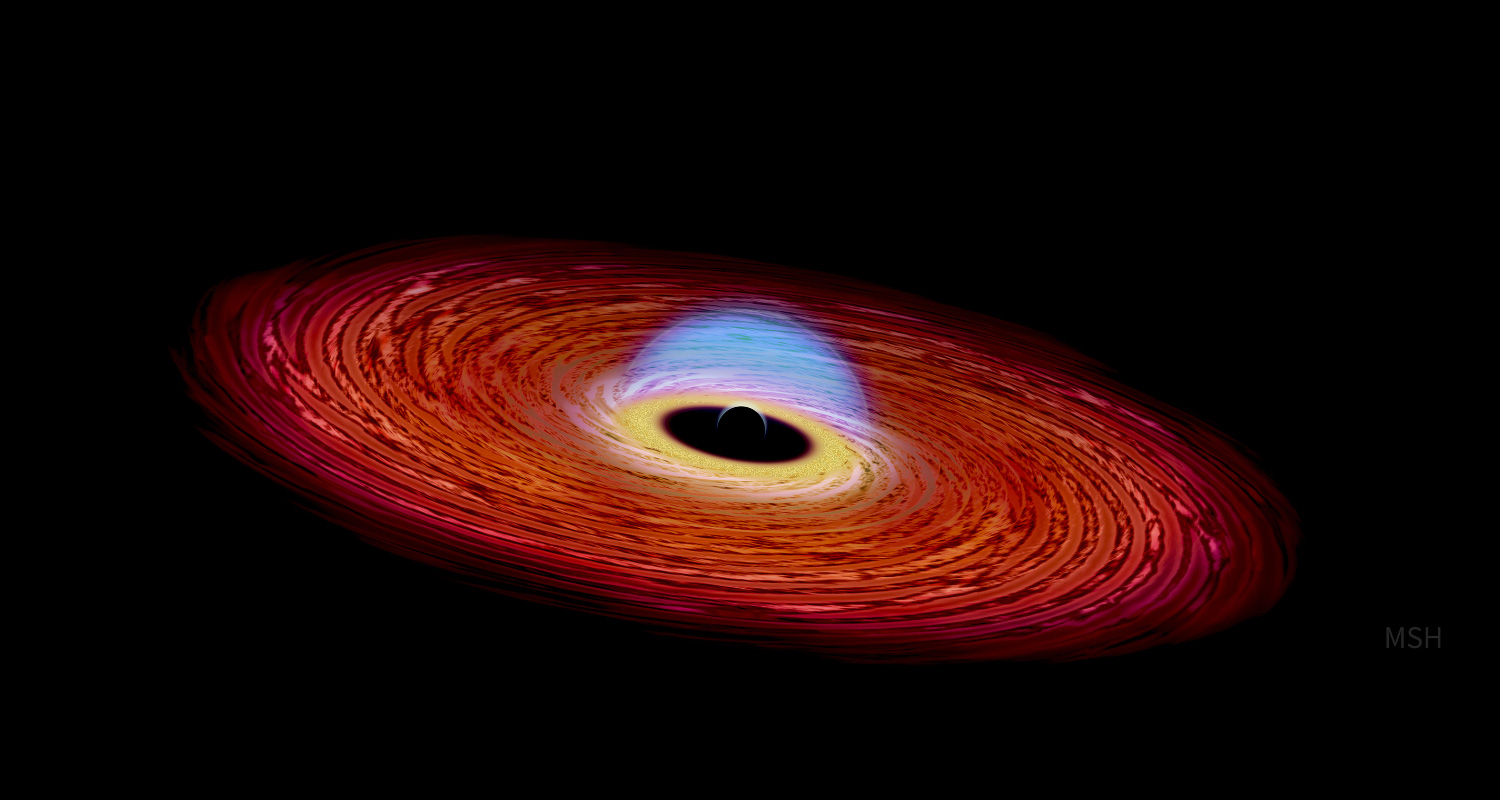Galactic Beacons Get Snuffed Out in a Cosmic Eyeblink

The hot accretion disk swirling into a supermassive black hole extends for trillions of kilometers. How could it suddenly shut down?
Jessica Rossier for Quanta Magazine
Introduction
Stephanie LaMassa did a double take. She was staring at two images on her computer screen, both of the same object — except they looked nothing alike.
The first image, captured in 2000 with the Sloan Digital Sky Survey, resembled a classic quasar: an extremely bright and distant object powered by a ravenous supermassive black hole in the center of a galaxy. It was blue, with broad peaks of light. But the second image, measured in 2010, was one-tenth its former brightness and did not exhibit those same peaks.
The quasar seemed to have vanished, leaving just another galaxy.
That had to be impossible, she thought. Although quasars turn off, transitioning into mere galaxies, the process should take 10,000 years or more. This quasar appeared to have shut down in less than 10 years — a cosmic eyeblink.
LaMassa, an astronomer now at the Space Telescope Science Institute, was mystified. Until that moment in 2014, she, like so many others, had expected quasars to be relatively stagnant. “Then you see these drastic changes within a human lifetime, and it’s pretty cool,” she said.
Confusion turned into excitement, and a hunt began to find more of these oddities. Although less luminous examples had already been seen, astronomers wanted to know if changes as dramatic as the one LaMassa discovered were common. It was no straightforward task, given that surveys tend not to go back and look at objects they have previously observed. But astronomers searched through archived data and discovered 50 to 100 more of what became known as “changing-look quasars.” Some of these have dimmed substantially more than LaMassa’s first example. Others have transitioned in the space of a month or two. And others, after disappearing, have reappeared again.
“It’s clear that the reason we weren’t finding these objects before is that we weren’t looking for them,” said Eric Morganson, an astronomer at the University of Illinois.
But how could such massive objects — superluminous beacons generated by solar-system-scale vortexes of gas and dust swirling into black holes with the mass of millions of suns — shut down so quickly? At first, astronomers refused to believe that they could, instead suggesting that these weren’t quasars at all, but rather supernovas and flaring stars masquerading as such. Or perhaps dust clouds were temporarily blocking our view.
But those ideas have largely failed to match what astronomers see. Within the past year a number of observations have peered more closely at these systems, providing details that suggest the accretion disk — that swirl of hot matter that encircles the black hole and gives these objects their dazzling luminosity — appears to flicker on and off. In parallel, theoretical astrophysicists have brainstormed how this change might happen. “It’s a little crazy that this whole system, which is just so enormous, is changing that quickly,” Morganson said.
Black Hole Doppelgängers
For the last four years, astronomers have attempted to understand changing-look quasars using the simplest theories possible. At first, that meant finding scenarios that did not require sweeping changes in the accretion disk.
To understand why, it helps to consider the size of these systems. If you could plop a quasar on top of the solar system, the supermassive black hole would swallow the sun, while the accretion disk would stretch out tens of thousands of times farther than Earth. To turn the quasar off, all of that material would have to swirl inward and fall onto the black hole — a process that calculations and even observations suggest should take tens to hundreds of thousands of years.
“There’s no way that the accretion should be able to shut down as quickly as we’ve seen it do,” said Paul Green, an astrophysicist at the Harvard-Smithsonian Center for Astrophysics. “The physics just doesn’t really make sense.”
So astronomers considered other possibilities. When LaMassa first made her startling discovery in 2014, she postulated that a massive dust cloud passed in front of the quasar’s bright beacon and momentarily blocked its light. But when she and her colleagues tried to model that scenario, they found that only an overly complex situation with multiple clouds could reproduce the observations. It seemed far too unlikely. To boot, any change would have taken much longer than a few years.
Others considered whether these objects weren’t quasars at all. In 2015, Andrea Merloni at the Max Planck Institute for Extraterrestrial Physics in Germany suggested that perhaps LaMassa’s object was actually a star that passed too close to the black hole and was torn apart, creating a bright flare. Similarly, others have argued that the purported quasars were actually powerful supernovas.
Both possibilities would outshine their host galaxies, much like quasars, and might even emit similar wavelengths of light. Then the light from these events would fade over the course of a few months to years — thus matching the timescale behind changing-look quasars. But the problem was that the light would also fade with a particular signature, one that astronomers didn’t see.
So researchers have recently turned back toward quasars. They’ve been helped by several new studies that have explored the swirling disk of matter itself.
In 2017, Zhenfeng Sheng, an astronomer at the University of Science and Technology of China, and his colleagues examined multiple changing-look quasars in both visible and infrared light. Those wavelengths allowed the team to view not only each quasar’s accretion disk, but also its torus — the doughnut-shape ring of dust clouds that wraps around the accretion disk.
That’s important because the glowing accretion disk sends visible light toward the dark torus, where it is absorbed and re-emitted as infrared light. Because of this, any change in the accretion disk will later be echoed within the torus. Sheng and his colleagues saw just such an echo (as did other studies), allowing them to conclude that it must be a sign of a change in the amount of material flowing through the accretion disk.
Just how this sweeping change occurs is still a matter of debate — but many hypotheses have recently emerged.
Half-Eaten Buffets and Shape-Shifters
It could be that a quasar does not have to clear its plate completely in order to shut down. One way to understand this is to break up the accretion disk into separate parts: a bright inner region that illuminates an outer dull region. Then if the black hole consumes the inner region (a process that could occur in mere months), the inner disk will disappear, and without its bright beacon, the outer disk will grow dark — much like the death of the sun would cause the moon to lose its shine.
“We kind of thought these were just hungry guys at a buffet,” Morganson said. “If there is just an infinite amount of food in front of them, they were just going to keep eating as fast as they could, and then they would remain relatively stable. But instead we find that they’re just taking breaks when the food is still there.”
Or it could be that the accretion disk changes its shape. It sounds wild, but this year studies of two different quasars found evidence to support this theory based on another echo. In each, the ultraviolet and blue colors fell away first, followed by the green and finally the red. That sequence flows from highest-energy colors to lowest-energy colors. It therefore resembles changes that ripple from the inner disk to the outer disk. “Something is causing the accretion disk to dim from the inside-out,” said Barry McKernan, an astrophysicist at the American Museum of Natural History.
Because the colors don’t completely disappear, the researchers don’t suspect that the inner accretion disk was completely swallowed by the black hole. Instead, they think that a cooling front swept out from the supermassive black hole at an incredible clip. The red colors, for example, dropped merely a year after the green colors.
That speed is important, McKernan noted, because it can reveal hints about the structure of the disk. If the disk is viscous and turbulent, then it’s fairly easy to send information through it. (Just think about the fact that sound travels faster in water than in air.) So McKernan argues that the disk must be viscous and therefore fairly puffed up — a doughnut, not a DVD — before collapsing into a thin disk once the cool front passes through.
But a second hypothesis suggests just the opposite: The accretion disk starts thin before puffing up. This is precisely what astronomers think occurs when stellar mass black holes — supermassive black holes’ lower-mass doppelgängers — turn inactive. When they’re accreting a lot of mass onto the black hole, their accretion disk is quite thin and luminous. But when that accretion rate drops, the disk puffs up into a quasi-spherical structure that struggles to emit light.


A changing-look quasar goes from bright (top) to dim in just a few years.
A changing-look quasar goes from bright (left) to dim in just a few years.
Michael S. Helfenbein/Yale University
Hirofumi Noda from Tohoku University in Japan and Chris Done from Durham University in England wanted to see if such a puffing-up could also be responsible for changing-look quasars. So this year, they applied their models for the accretion disks around stellar mass black holes to those around supermassive black holes. They found that this change could happen in a quasar’s accretion disk, and fast (though not as fast as decades).
Astronomers can’t yet say if the supermassive black hole has been starved, if the disk itself has shape-shifted — either puffing up or caving in — or if an entirely different mechanism is responsible. It’s still unclear how gas in the accretion disk flows from an orbit at a large radius to one near the black hole and how it finally falls onto the black hole. And other factors — magnetic fields, for example — likely play a crucial role that astronomers don’t yet understand. “It’s a failure of our imagination,” said Meg Urry, an astrophysicist at Yale University.
A Murder-Suicide Pact
While the details remain hazy, a better understanding of how gas and dust flow onto a black hole will do more than answer our sheer curiosity; it will help explain how galaxies evolve.
Nearly 20 years ago, astronomers discovered that the mass of a supermassive black hole is tightly correlated with the mass of the entire galaxy. In fact, the black hole actually truncates a galaxy’s growth, causing it to be 10 to 100 times smaller than simulations predict. “The gravitational sphere of influence of a black hole is tiny in comparison to an entire galaxy,” said John Ruan, an astrophysicist at McGill University. “So why is there such a close relation between the two?”
When the correlation was first discovered, the answer to that question was a mystery, but astronomers now suspect that quasars can wreak havoc on their host galaxy — and the effects are surprisingly far-reaching. A quasar’s extreme wind drives dust and gas outside of the galaxy. Its extreme luminosity heats any leftover gas to such high temperatures that new stars can’t form. It effectively starves both itself and its host galaxy of the stars required to stay alive in “a murder-suicide pact,” said Gordon Richards, a physicist at Drexel University.
At least that’s the current thinking. It has been extremely hard to pin down the details because astronomers can’t observe a distant quasar and its galaxy simultaneously — the quasar is simply too bright. If astronomers could set up cosmic experiments, however, they would study a quasar and then turn off the switch, causing it to grow dark. Changing-look quasars are precisely this experiment, Ruan said, offering an unprecedented opportunity to better understand a quasar’s far-reaching effects.
But to truly grasp this relationship, astronomers will need a large sample of changing-look quasars. And to find them, they will have to return time and again to the same quasars and galaxies to spot any changes. Already, the Zwicky Transient Facility in California has been mapping the sky since 2017, returning to the same objects nearly 300 times per year. And many more facilities are soon to come online. The Large Synoptic Survey Telescope, for example, planned for 2022, will map the entire sky in five colors every night. “We’ll have a color movie of the whole sky that will just discover millions of fascinating oddball objects like this,” Green said.
McKernan is on the fence about how lucky we’ll be in the future. In optimistic moments, he imagines those surveys might help astronomers catch a break. “If we’re in the right place at the right time such that we can catch one of these things as it’s happening and follow it with several instruments, we might get a breakthrough,” he said. “That might be our Rosetta stone.” Though it would still require a stroke of luck, such an observation might even help describe our Milky Way down the road.
In roughly five billion years, after all, our galaxy and the Andromeda galaxy will collide — likely sparking yet another quasar and throwing our night sky into disarray. But a clearer foresight into those details could come from better understanding this mysterious disappearing act.



